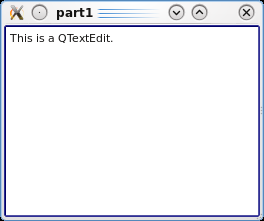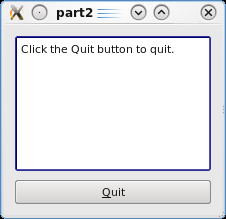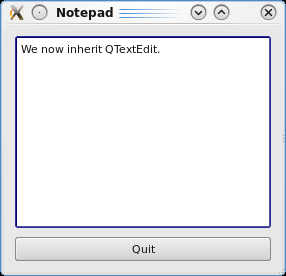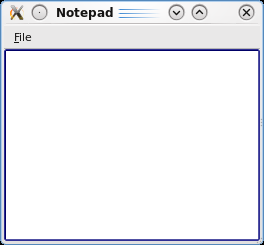Getting Started Programming with Qt
Welcome to the world of Qt--the cross-platform GUI toolkit. In this getting started guide, we teach basic Qt knowledge by implementing a simple Notepad application. After reading this guide, you should be ready to delve into our overviews and API documentation, and find the information you need for the application you are developing.
Hello Notepad
In this first example, we simply create and show a text edit in a window frame on the desktop. This represents the simplest possible Qt program that has a GUI.

Here is the code:
1 #include <QApplication> 2 #include <QTextEdit> 3 4 int main(int argv, char **args) 5 { 6 QApplication app(argv, args); 7 8 QTextEdit textEdit; 9 textEdit.show(); 10 11 return app.exec(); 12 }
Let us go through the code line by line. In the first two lines, we include the header files for QApplication and QTextEdit, which are the two classes that we need for this example. All Qt classes have a header file named after them.
Line 6 creates a QApplication object. This object manages application-wide resources and is necessary to run any Qt program that has a GUI. It needs argv and args because Qt accepts a few command line arguments.
Line 8 creates a QTextEdit object. A text edit is a visual element in the GUI. In Qt, we call such elements widgets. Examples of other widgets are scroll bars, labels, and radio buttons. A widget can also be a container for other widgets; a dialog or a main application window, for example.
Line 9 shows the text edit on the screen in its own window frame. Since widgets also function as containers (for instance a QMainWindow, which has toolbars, menus, a status bar, and a few other widgets), it is possible to show a single widget in its own window. Widgets are not visible by default; the function show() makes the widget visible.
Line 11 makes the QApplication enter its event loop. When a Qt application is running, events are generated and sent to the widgets of the application. Examples of events are mouse presses and key strokes. When you type text in the text edit widget, it receives key pressed events and responds by drawing the text typed.
To run the application, open a command prompt, and enter the directory in which you have the .cpp file of the program. The following shell commands build the program.
qmake -project
qmake
make
This will leave an executable in the part1 directory (note that on Windows, you may have to use nmake instead of make. Also, the executable will be placed in part1/debug or part1/release). qmake is Qt's build tool, which takes a configuration file. qmake generates this for us when given the -project argument. Given the configuration file (suffixed .pro), qmake produces a make file that will build the program for you. We will look into writing our own .pro files later.
Learn More
| About | Here |
|---|---|
Widgets and Window Geometry | |
Events and event handling |
Adding a Quit Button
In a real application, you will normally need more than one widget. We will now introduce a QPushButton beneath the text edit. The button will exit the Notepad application when pushed (i.e., clicked on with the mouse).

Let us take a look at the code.
1 #include <QtGui> 2 3 int main(int argv, char **args) 4 { 5 QApplication app(argv, args); 6 7 QTextEdit textEdit; 8 QPushButton quitButton("Quit"); 9 10 QObject::connect(&quitButton, SIGNAL(clicked()), qApp, SLOT(quit())); 11 12 QVBoxLayout layout; 13 layout.addWidget(&textEdit); 14 layout.addWidget(&quitButton); 15 16 QWidget window; 17 window.setLayout(&layout); 18 19 window.show(); 20 21 return app.exec(); 22 }
Line 1 includes QtGui, which contains all of Qt's GUI classes.
Line 10 uses Qt's Signals and Slots mechanism to make the application exit when the Quit button is pushed. A slot is a function that can be invoked at runtime using its name (as a literal string). A signal is a function that when called will invoke slots registered with it; we call that to connect the slot to the signal and to emit the signal.
quit() is a slot of QApplication that exits the application. clicked() is a signal that QPushButton emits when it is pushed. The static QObject::connect() function takes care of connecting the slot to the signal. SIGNAL() and SLOT() are two macros that take the function signatures of the signal and slot to connect. We also need to give pointers to the objects that should send and receive the signal.
Line 12 creates a QVBoxLayout. As mentioned, widgets can contain other widgets. It is possible to set the bounds (the location and size) of child widgets directly, but it is usually easier to use a layout. A layout manages the bounds of a widget's children. QVBoxLayout, for instance, places the children in a vertical row.
Line 13 and 14 adds the text edit and button to the layout. In line 17, we set the layout on a widget.
Learn More
| About | Here |
|---|---|
Signals and slots | |
Layouts | |
The widgets that come with Qt |
Subclassing QWidget
When the user wants to quit an application, you might want to pop-up a dialog that asks whether he/she really wants to quit. In this example, we subclass QWidget, and add a slot that we connect to the Quit button.

Let us look at the code:
5 class Notepad : public QWidget 6 { 7 Q_OBJECT 8 9 public: 10 Notepad(); 11 12 private slots: 13 void quit(); 14 15 private: 16 QTextEdit *textEdit; 17 QPushButton *quitButton; 18 };
The Q_OBJECT macro must be first in the class definition, and declares our class as a QObject (Naturally, it must also inherit from QObject). A QObject adds several abilities to a normal C++ class. Notably, the class name and slot names can be queried at run-time. It is also possible to query a slot's parameter types and invoke it.
Line 13 declares the slot quit(). This is easy using the slots macro. The quit() slot can now be connected to signals with a matching signature (any signal that takes no parameters).
Instead of setting up the GUI and connecting the slot in the main() function, we now use Notepad's constructor.
Notepad::Notepad()
{
textEdit = new QTextEdit;
quitButton = new QPushButton(tr("Quit"));
connect(quitButton, SIGNAL(clicked()), this, SLOT(quit()));
QVBoxLayout *layout = new QVBoxLayout;
layout->addWidget(textEdit);
layout->addWidget(quitButton);
setLayout(layout);
setWindowTitle(tr("Notepad"));
}
As you saw in the class definition, we use pointers to our QObjects (textEdit and quitButton). As a rule, you should always allocate QObjects on the heap and never copy them.
We now use the function tr() around our user visible strings. This function is necessary when you want to provide your application in more than one language (e.g. English and Chinese). We will not go into details here, but you can follow the Qt Linguist link from the learn more table.
Learn More
| About | Here |
|---|---|
tr() and internationalization | Qt Linguist Manual, Writing Source Code for Translation, Hello tr() Example, Internationalization with Qt |
QObjects and the Qt Object model (This is essential to understand Qt) | |
qmake and the Qt build system |
Creating a .pro file
For this example, we write our own .pro file instead of using qmake's -project option.
HEADERS = notepad.h
SOURCES = notepad.cpp \
main.cpp
The following shell commands build the example.
qmake
make
Using a QMainWindow
Many applications will benefit from using a QMainWindow, which has its own layout to which you can add a menu bar, dock widgets, tool bars, and a status bar. QMainWindow has a center area that can be occupied by any kind of widget. In our case, we will place our text edit there.

Let us look at the new Notepad class definition.
#include <QtGui> class Notepad : public QMainWindow { Q_OBJECT public: Notepad(); private slots: void open(); void save(); void quit(); private: QTextEdit *textEdit; QAction *openAction; QAction *saveAction; QAction *exitAction; QMenu *fileMenu; };
We include two more slots that can save and open a document. We will implement these in the next section.
Often, in a main window, the same slot should be invoked by several widgets. Examples are menu items and buttons on a tool bar. To make this easier, Qt provides QAction, which can be given to several widgets, and be connected to a slot. For instance, both QMenu and QToolBar can create menu items and tool buttons from the same QActions. We will see how this works shortly.
As before, we use the Notepads constructor to set up the GUI.
Notepad::Notepad()
{
saveAction = new QAction(tr("&Open"), this);
saveAction = new QAction(tr("&Save"), this);
exitAction = new QAction(tr("E&xit"), this);
connect(openAction, SIGNAL(triggered()), this, SLOT(open()));
connect(saveAction, SIGNAL(triggered()), this, SLOT(save()));
connect(exitAction, SIGNAL(triggered()), qApp, SLOT(quit()));
fileMenu = menuBar()->addMenu(tr("&File"));
fileMenu->addAction(openAction);
fileMenu->addAction(saveAction);
fileMenu->addSeparator();
fileMenu->addAction(exitAction);
textEdit = new QTextEdit;
setCentralWidget(textEdit);
setWindowTitle(tr("Notepad"));
}
QActions are created with the text that should appear on the widgets that we add them to (in our case, menu items). If we also wanted to add them to a tool bar, we could have given icons to the actions.
When a menu item is clicked now, the item will trigger the action, and the respective slot will be invoked.
Learn More
| About | Here |
|---|---|
Main windows and main window classes | |
MDI applications |
Saving and Loading
In this example, we will implement the functionality of the open() and save() slots that we added in the previous example.

We will start with the open() slot:
QString fileName = QFileDialog::getOpenFileName(this, tr("Open File"), "", tr("Text Files (*.txt);;C++ Files (*.cpp *.h)")); if (fileName != "") { QFile file(fileName); if (!file.open(QIODevice::ReadOnly)) { QMessageBox::critical(this, tr("Error"), tr("Could not open file")); return; } QString contents = file.readAll().constData(); textEdit->setPlainText(contents); file.close(); }
The first step is asking the user for the name of the file to open. Qt comes with QFileDialog, which is a dialog from which the user can select a file. The image above shows the dialog on Kubuntu. The static getOpenFileName() function displays a modal file dialog, and does not return until the user has selected a file. It returns the file path of the file selected, or an empty string if the user canceled the dialog.
If we have a file name, we try to open the file with open(), which returns true if the file could be opened. We will not go into error handling here, but you can follow the links from the learn more section. If the file could not be opened, we use QMessageBox to display a dialog with an error message (see the QMessageBox class description for further details).
Actually reading in the data is trivial using the readAll() function, which returns all data in the file in a QByteArray. The constData() returns all data in the array as a const char*, which QString has a constructor for. The contents can then be displayed in the text edit. We then close() the file to return the file descriptor back to the operating system.
Now, let us move on to the the save() slot.
QString fileName = QFileDialog::getSaveFileName(this, tr("Save File"), "", tr("Text Files (*.txt);;C++ Files (*.cpp *.h)")); if (fileName != "") { QFile file(fileName); if (!file.open(QIODevice::WriteOnly)) { // error message } else { QTextStream stream(&file); stream << textEdit->toPlainText(); stream.flush(); file.close(); } }
When we write the contents of the text edit to the file, we use the QTextStream class, which wraps the QFile object. The text stream can write QStrings directly to the file; QFile only accepts raw data (char*) with the write() functions of QIODevice.
Learn More
| About | Here |
|---|---|
Files and I/O devices |